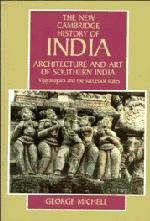2 - Historical framework
Published online by Cambridge University Press: 28 March 2008
Summary
The four hundred years or so under review in this volume delimit a remarkable sequence of events: the formation, climax and disintegration of the Vijayanagara empire, and the opportunity that this process gave for lesser kingdoms to achieve independence. The varied careers of the different states of Southern India in this period provide an overall historical framework for the buildings and art works to be discussed in the following chapters. The appropriateness of a dynastic approach is suggested by the many monuments and attendant sculptures and paintings that are directly linked with known reigning figures, their family members, commanders and governors. For this reason dynastic appellations are generally retained, especially for religious and royal monuments. But this should not be taken to mean that artistic developments at this time invariably coincided with dynastic history; considerable difficulties occur when assigning a precise chronology to certain phases of artistic activity, particularly painting and the minor arts.
The history of Southern India from the fourteenth to the eighteenth centuries is relatively well established and there is little need here to give more than the bare outlines of the major dynasties together with their prominent ruling personalities; even so, it is important to recognise the overall trends of the era. As the centuries progressed, larger states with some measure of political unity tended to collapse, thereby creating opportunities for smaller states to emerge. These smaller kingdoms were generally unable to bond together into larger political units, since they were mostly engaged in territorial conflicts with one another.
- Type
- Chapter
- Information
- Architecture and Art of Southern IndiaVijayanagara and the Successor States 1350–1750, pp. 7 - 24Publisher: Cambridge University PressPrint publication year: 1995

